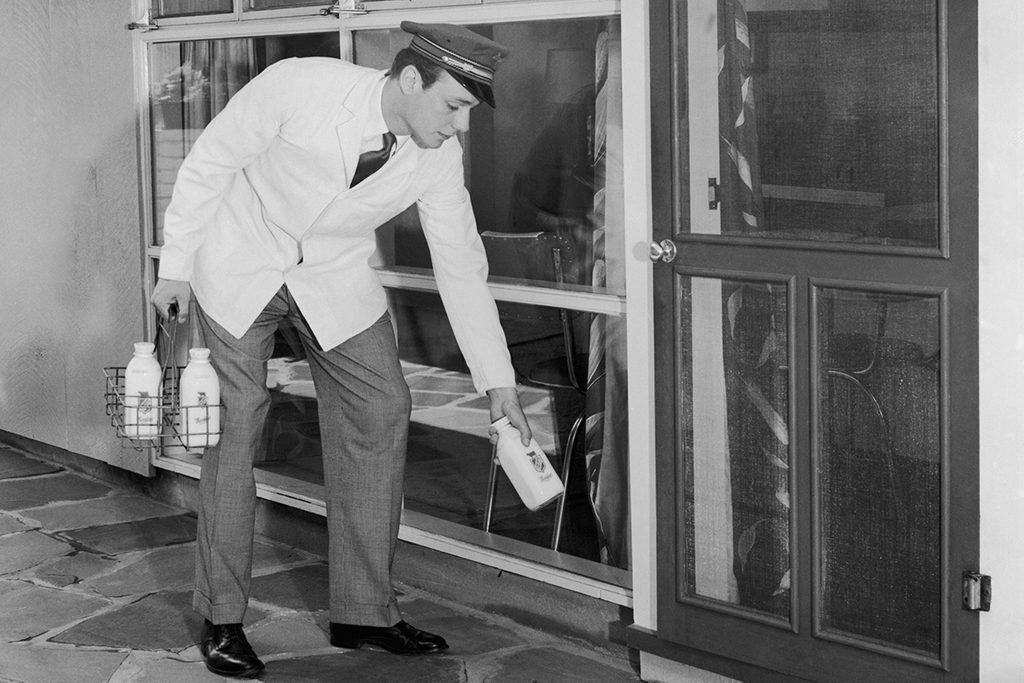Here’s the Price of Milk the Year You Were Born
Updated: Nov. 28, 2023

A century ago, a gallon of milk cost a mere 35¢. It sounds like milk prices have gone up by a lot—but that's not exactly true. Here's why.
Like many things at the grocery store, milk prices are linked to supply and demand. High supply and low demand equals lower prices. High demand and low supply equals higher prices. But milk in particular is unique, because its prices are also affected by our perception of milk’s health benefits. (See what foods have more calcium than milk.)
As a result, we’ve seen milk prices rise and fall, even as prices for most other products keep rising! Here’s a snapshot of what milk cost from 1930 to today:
1930: 26¢ per gallon
In the Roaring ’20s, milk was 35¢ or so per gallon. But when the Great Depression hit in 1929, fewer people could afford milk and dairy farmers still had a lot of milk to sell. The price dropped from 35¢ per gallon to 26¢ per gallon. It doesn’t sound like much, but 9¢ in 1930 is about $1.09 in today’s dollars.
The 1930s led resourceful bakers to make do with less. See what’s in these Depression-era desserts.
1935: 47¢ per gallon
The Depression stretched on, and dairy farmers started keeping fewer cows and producing less milk. The farmers also went on “milk strikes,” demanding the government’s help in raising prices. By 1935, efforts had paid off and milk prices were up again.
1940: 52¢ per gallon
In 1940, a new federal law required schools to provide all children with affordable milk. The demand for milk went up, and milk prices went up, too.
1945: 63¢ per gallon
Starting in the early 1940s, President Franklin D. Roosevelt’s New Deal subsidized milk advertisements (the Works Progress Association paid artists and marketing experts to create ads). More and more Americans came to see milk as a healthy necessity. The demand for milk increased, and so did prices.
1950: 83¢ per gallon
In 1946, the federal government passed the National School Lunch Act, which required that every school lunch include 1/2 to 2 pints of whole milk. The price of milk skyrocketed by 20 cents in five years. Serve a scoop of Tuna Noodle Casserole—or any other vintage 1950s recipes—with that half-pint of milk.
1955: 93¢ per gallon
In the mid-1950s, the dairy industry revolutionized its milk delivery system: paper milk cartons replaced glass bottles. The costs went down, which meant more Americans could afford to buy milk, and demand increased. (Prices did not increase as steeply as they might have because dairy farmers passed production savings on to the public. Thank you, farmers!)
1960: $1 per gallon
The “salad days” of milk continued through 1960, with milk prices increasing almost precisely in line with the rate of inflation. Feeling nostalgic? Don’t miss our recipes inspired by the Swingin’ 60s.
1965: $1.05 per gallon
Between 1960 and 1965, the milk industry remained stable, although by the end of 1965, milk prices were beginning to lag ever so slightly behind the rate of inflation.
1970: $1.32 per gallon
President Lyndon B. Johnson signed the Child Nutrition Act in 1966, which authorized the Special Milk Program (SMP). The SMP reimbursed schools for milk they served. This meant schoolchildren all over the country drank more milk, which raised prices in the short term but also motivated dairy farmers to increase production. By 1970, milk prices had reached $1.32 per gallon, right on par with the rate of inflation.
Help yourself to this collection of school lunch recipes—it will take you right back to your elementary school cafeteria!
1975: $1.57 per gallon
Inflation reached unusually high levels in the mid to late 1970s. Though milk prices went up, they thankfully did not keep up with the rate of inflation (that would’ve meant that milk cost a whopping $1.85 per gallon in 1975).
The federal government began requiring nutrition labels on all foods, including milk. With whole milk’s fat content in black and white on the carton, people began shying away from dairy.
1985: $2.20 per gallon
In response to the decreasing demand for milk, an iconic ad campaign was born: “Milk. It Does a Body Good.” The milk industry rallied, although due to such factors as nutrition labeling and a growing interest in low-fat foods, the price of milk still wasn’t keeping up with inflation.
1995: $2.50 per gallon
In 1990, the federal government passed more laws promoting the sale of milk. In 1992, The Food Guide Pyramid was introduced, which recommended that Americans consume two to three servings of milk and other dairy products daily. And in 1993, the iconic “Got Milk?” ad campaign was rolled out.
2005: $3.20 per gallon
By 2005, that milk-mustachioed “Got Milk” campaign had a 90% recognition rate among Americans. In fact, as a result of rapidly increasing demand for milk, milk prices zoomed to $3.20 per gallon, which is around 15% more than the rate of inflation!
2018: $2.90 per gallon
The demand for milk has fallen off in recent years. People are drinking less of all kinds of milk, both whole and low-fat. As the dairy industry considers ways to reverse the trend, we’ll keep an eye on all dairy prices and let you know what’s happening.